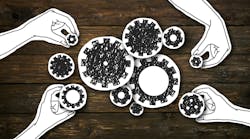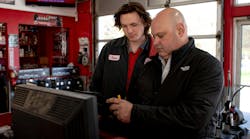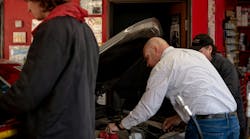Watching a presidential debate last week, I was reminded of one of the most successful presidential campaigns. In 1992, James Carville, who was then-Governor Clinton’s campaign manager, came up with a slogan that launched Governor Clinton’s campaign past his competitors. For those of us who were born prior to 1974, we will remember his famous campaign slogan that was plastered on everything Clinton: “It’s the economy, stupid.” Regardless of which side of the aisle your politics were on, it resonated. Carville hit a nerve with the voting public that soon pushed Clinton past his rivals. He even surpassed the one-term President Bush, who was a popular president and former vice president to President Reagan.
Last month, I suggested some topics for the monthly shop meeting in bite-size pieces. The importance of clear communication and honesty seemed to resonate. When I am conducting an operation training event in the field, it’s odd to me the points that seem to get the most attention are the things we already know. We have just lost our way and need to be reminded of what works best. Recently, after I had finished my session about the importance of clear communication and honesty, one of the attendees came up to me and said, “I guess my mother was right.” I smiled and asked, “How’s that?” and he said, “You didn’t tell me anything that my mother hadn’t already told me as a child.” We laughed, and I reminded him that he has a good momma. It also reconfirmed my theory that as we age as people, we will eventually become who we were when we were in kindergarten, but that’s another story.
After more positive feedback from various shops and from our support organizations, I thought I would offer a topic for this month’s roundtable with the shop. In a nutshell, you can title this month’s meeting: “It’s the Customer, Stupid!”
One of the things I get asked from time to time is to evaluate a company’s mission statement or their motto. They want to print out some poster-size mission statement and place the posters strategically around the shop. It always stuns me when I see these banners hanging in the waiting rooms, it never says anything about how important the customers are within the mission statement.
At the end of last year, I was in our local branch of one of the national banks. Above the teller lanes, which had one person behind the counter and five stations, this powerhouse bank had their mission statement. Below the mission statement, which included the bank’s desire to serve their communities, it listed the top 10 priorities for the bank. Customer service was number five. Now it didn’t come straight out and say customer service written behind the number five. It had some mumbo-jumbo language to it. The lady in front of me started reading between the lines and, sure enough, the bank’s desire was to be more profitable, efficient, environmentally friendly, technologically advanced and then customer focused. I couldn’t believe it! That crazy bank put in writing that customer service was not a priority, which explained why I was standing in a line behind several other people. The bank made it clear that their goals were to cut costs. Not long after, they closed their drive-up lanes and forced everyone to come inside, stand behind the rope and wait as one teller processed their banking needs. Last month, this same bank announced they were closing this branch and consolidating the bank’s “footprint” in our community. I guess it made sense. After all, their goals were to be more profitable, efficient, environmentally friendly, blah, blah, blah.
It’s the Customer, Stupid!
In a time where competition for our customers’ vehicles’ maintenance needs is fierce, taking care of the customer must be No. 1. As one of my former sales reps used to tell me, “You have to be easy to do business with.”
How can you be easy? The bank story is an example of the frustration of a customer when they come in and see five available teller lanes but only one open. Applying this to a quick lube application, it’s frustrating for a customer to pull onto our parking lot and see three available bays and only one open. The other two bays have the orange cones in front of them, or worse, the shop doors closed and one bay door open. It is a visual statement to the customer you are looking out for yourself and not the customers’ needs.
However, I know there are times when you cannot help the fact that you are short on staff to open all available bays. What do you do then? In this case, you have to make sure that someone greets the customer as soon as they pull onto the drive. In fact, I would suggest that you not only greet them, but also call them by name. The next step is to start the service as soon as possible. Our customers will wait if they know the service starts as soon as they pull up. I would encourage you to wash the windows or check the tire pressure while they are waiting. I have seen shops that not only wash windows and check the tire pressure while the car is outside the shop, but they start the pre-check procedure of checking oil and other fluids as well as the air filter and cabin filter while the car is outside. Customers will wait for the rest of the service if you will demonstrate that the service begins as soon as they pull up. At a minimum, greet the customer as soon as they pull onto your property.
One of the recurring issues we struggle with as owners or managers is we do a good job training how to service the vehicle, but we fall short training that a person is driving that vehicle — and serving those drivers is as important as the quality of the service to the vehicle.
It is what the founder of Neiman Marcus said, “Consumers are statistics. Customers are people.” In our industry, where we live and breathe by statistics, it is vital we separate the person from the vehicle. Industry studies show customers already assume we know how to do the job. An area where we fall short in meeting their expectations is in how we serve the person. Recently, I have started presenting my customer service spiel by saying, “Remind yourself it is the person you are working for, not the vehicle.” The person already assumes you know how to perform the service on their vehicles; what they want is for you to take care of them.
A quick and easy way to pamper your customer is to keep them informed as you proceed. An interesting observation is to watch a customer once the hood goes down on their vehicle. As soon as the hood goes down, they are ready to leave the shop. Remind the staff that as soon as you are finished servicing the vehicle, cash the customer out. A shop can complete the service in a perfect way, including tending to the customer’s needs, and then blow the whole thing by making them wait to be cashed out. Once the hood of the vehicle comes down, customers are ready to go. After all, they have gotten what they came for; they just need to pay for it. A well-worked plan that I have witnessed in several shops, is to cash out the customer just prior to the completion of the service. Normally in the quick maintenance business, we start the vehicle to ensure the drain plug is tight and the oil filter was installed correctly. This step is a good cue for the cashier to cash the customer out. In a process like that, the hood technician can give a detailed explanation of the service performed and can be the last one to say thank you, then close the hood and send a happy customer on their way. By utilizing this process, the last thing that happens is the customer hears about the service from the one who performed the service, which is much more pleasant than being cashed out.
Do you have unique customer service procedures? Tell me about them and, if you would like, I will include them in another article.





